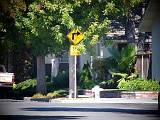Zoom Range
The zooming ability of a camera gives it more latitude. From the same vantage
point, you can adjust the zoom to frame a subject or to isolate different points
of interest. Optical zoom helps to increase image definition as it enlarges the
image. When you have reached the optical zoom limit, you can increase the size
of the image further by using digital zoom. However, digital zoom merely
expands the image through some upsampling algorithm and does not provide any more
detail. With some fixed lens cameras, it may be possible to extend the optical zoom range
by attaching an adapter lens in front of the basic lens that can either provide
more magnification for more telephoto distance or decreased magnification to
provide a broader field of view (FOV).
The FZ10 has a 12x zoom range that extends the focal length from 6 to 72 mm with a 4:3 image format. Based on it's
sensor size, the zoom range equates to a range of 35 mm to 420 mm when compared to the image coverage of a standard 35 mm
film format. I have a 1.7x teleconverter lens and a 0.66 wideangle adapter lens to extend the optical zoom range on the FZ10.
The first five images below illustrates the FOV at various zoom settings.and effects of the adapter lenses.
The LX2 has a 4x zoom range that extends the focal length from 6.3 to 25.2 mm. Its has a sensor with an image format of 16:9
that produces a 28mm image diagonal compared to an equivalent 35mm film camera. You can select image aspect ratios of 3:2 and
4:3 but the image is truncated and not as wide. By selecting a lower image resolution, you can can extend the optical zoom range up to
6.2x. Although this is similar to cropping out a smaller portion of the image, doing it at the time of shooting allow one to frame the
image better around the subject of interest and get more precise focusing and metering of the specific area. The next
seven images below illustrates the FOV as the image format is varied and other zoom controls are applied.
The LX3 has a wider field of view equivalent to 24mm, but only a 2.5x zoom range that extends from 5 to 13 mm. In this design,
the image diagonal is maintaned regardless of which image aspect ratio (16:9, 3x2, or 4:3) is selected. By decreasing the image size
you can also apply extended optical zoom up to 4.5x. It is also possible to add adapter lenses to extend the zoom
range. My existing set of converter lenses didn't seem to provide any worthwhile benefits. But after seeing reasonable wide angle results by other
photographers using an inexpensive Opteka .45x WA, I decided to buy one and give it a try. The last eight images illustrate the FOV provided by the LX3.
The Nikon DSLR System's zoom range will depends primarily on the collection of
interchangeable lenses that one has to support the system. Since lens acquisitions can become quite expensive, I have decided to
do it deliberately and let my immediate needs and budget guide my purchases.
Tne Micro Four-Thirds (M43) Cameras are also interchangeable lens system and the zoom range will depend primarily on
the M43 collection of lenses that one has to support it. One interesting
thing about the M43 cameras is that legacy lenses belonging to other systems can be adapted for use with the
camera but all lens adjustments will need to be performed manually.




